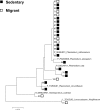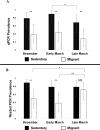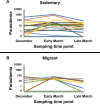Sedentary songbirds maintain higher prevalence of haemosporidian parasite infections than migratory conspecifics during seasonal sympatry
- PMID: 30133475
- PMCID: PMC6104930
- DOI: 10.1371/journal.pone.0201563
Sedentary songbirds maintain higher prevalence of haemosporidian parasite infections than migratory conspecifics during seasonal sympatry
Abstract
Long-distance migrations influence the physiology, behavior, and fitness of migratory animals throughout their annual cycles, and fundamentally alter their interactions with parasites. Several hypotheses relating migratory behavior to the likelihood of parasitism have entered the literature, making conflicting, testable predictions. To assess how migratory behavior of hosts is associated with parasitism, we compared haemosporidian parasite infections between two closely related populations of a common North American sparrow, the dark-eyed junco, that co-occur in shared habitats during the non-breeding season. One population is sedentary and winters and breeds in the Appalachian Mountains. The other population is migratory and is found in seasonal sympatry with the sedentary population from October through April, but then flies (≥ 900 km) northwards to breed. The populations were sampled in the wild on the shared montane habitat at the beginning of winter and again after confining them in a captive common environment until the spring. We found significantly higher prevalence of haemosporidian parasite infections in the sedentary population. Among infected juncos, we found no difference in parasite densities (parasitemias) between the sedentary and migrant populations and no evidence for winter dormancy of the parasites. Our results suggest that long-distance migration may reduce the prevalence of parasite infections at the population level. Our results are inconsistent with the migratory exposure hypothesis, which posits that long-distance migration increases exposure of hosts to diverse parasites, and with the migratory susceptibility hypothesis, which posits that trade-offs between immune function and migration increase host susceptibility to parasites. However, our results are consistent with the migratory culling hypothesis, which posits that heavily infected animals are less likely to survive long-distance migration, and with the migratory escape hypothesis, which posits that long-distance migration allows host populations to seasonally escape areas of high infection risk.
Conflict of interest statement
The authors have declared that no competing interests exist.
Figures




References
-
- Dingle H, Drake VA. What is migration? BioScience. 2007;57(2):113–21. 10.1641/B570206 - DOI
-
- Alerstam T, Hedenström A, Åkesson S. Long-distance migration: evolution and determinants. Oikos. 2003;103(2):247–60.
-
- Bradley CA, Altizer S. Parasites hinder monarch butterfly flight: implications for disease spread in migratory hosts. Ecology Letters. 2005;8(3):290–300. 10.1111/j.1461-0248.2005.00722.x PubMed PMID: WOS:000227249400007. - DOI
Publication types
MeSH terms
Grants and funding
LinkOut - more resources
Full Text Sources
Other Literature Sources
Miscellaneous

